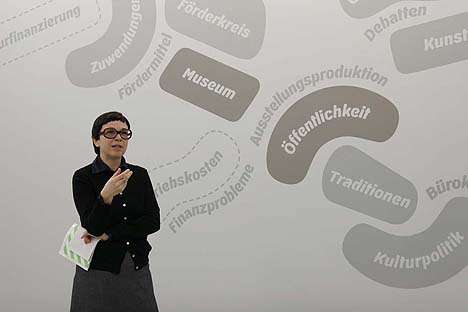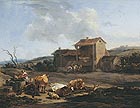
translated and summarized by: Liz Wollner-Grandville,
English summary February 25 - March 3
GfzK - Galerie für zeitgenössische Kunst: Friendly enemies
Exhibit with a price tag
I would like to exhibit 23 international artists and 37 works of art for two months. And please add a little "Neue Leipziger Schule", some Minimal Art, one Gursky and three photographs by Louise Lawler. Would that be all? Yes, that’s it, thank you. OK, altogether that makes € 25.540.
The price tag is stuck onto the "shop window" of the new building of the GfzK. It symbolizes the amount of money paid for this exhibit, in which the "Friendly enemies" of the museum (gallery owners, collectors, corporations) are gathered. The show is the kick-off event for the two-year project "Carte Blanche" organized by the GfzK. All of the ten participants invited to take part in this project have been given the unlimited power (= carte blanche) to organize an exhibit of whatever wish, but - and this is the piquant detail: they must pay all of the direct and indirect costs involved. Already in the fore field this radical venture raised a lot of dust; after all, its goal was to make the flow of private financial money supporting art-exhibits in public museums more visible. Throughout the entire exhibit you will find price tags: heating and electricity 2.401 euros, cleaning 495 euros, guards, 6 euros per hour.
Since none of those invited had the courage to be the first to enter the ‘ring’ of this controversial project, all of the "friendly enemies" loans are shown. This pragmatic step pays off and itself becomes the program of the display. Focus is laid on the relationship between economy and art. In his pointedly amateurish video "Save me, help me…" Jakup Ferris holds paintings into the camera, which he would like to sell. At the same time he brings up the question, which chances an artist from the Kosovo has to become part of the international art market. Rosemarie Trockel’s photo series "Das Capital (Alice in Wonderland)", which criticises market mechanisms and its reference to the art price index of a magazine, is positioned next to Neo Rauch’s expensive works. Art itself is asked to speak up. And there is certainly no danger that the project might only debate the economization of art on the sidelines.
GfzK - Galerie für zeitgenössiche Kunst,
04107 Leipzig, Karl Tauchnitz-Str. 11, until 24. 03. 08
www.gfzk.de
Essl Museum: Jörg Immendorff - What painting can mean to us
Trendsetter and epigone
One must admit: Jörg Immendorff composed some really awe-inspiring paintings. Such as the "Ostjörg" (1980), which depicts a traumatic paraphrase of east-west politics similar to the friendship among artists in a venomous-yellow atmosphere. Or the untitled painting on which you see the artist himself and his friend A.R. Penck, both using tongs to pull at a piece of barbed wire, guarded by the omnipresent eagle. And even the (maybe not so) self-deprecating work "I wanted to become an artist" (1972) with its lapidary combination of text and painting, is extremely impressive. Immendorff compresses symbolic and narrative elements, pours them into a strong composition; the colouring being partly absolutely magnificent.
In the centre of the exhibit are not Immendorff’s works from the late 70s and early 80s - the period from which his most fascinating work originated - but rather the series of his works "In meinem Salon Österreich", which he named after Berta Zuckerkandl’s biography. It shows the collectors Agnes and Karl Heinz Essl sitting at a table with the Austrian artists Maria Lassnig, Arnulf Rainer, Hermann Nitsch and Christian Ludwig Attersee. Tayfun Belgin describes the painting blatantly "as a gorgeously artistic tribute to the collector couple Essl". In addition, the exhibition also displays illustrations, which Immendorff obviously created rather "en passant" during his visits to Austria.
During his best years Immendorff developed trends; toward the end he lagged behind them. On account of his illness he was no longer able to paint in his last years, and assistants worked according to his instructions. He composed seemingly esoteric, collage-like scenes in which one detects German art history motives, or Hitler in an encounter with Duchamp. Sometimes a sprayed grate will show up - something Sigmar Polke could have created many decades ago.
Essl Museum
3400 Klosterneuburg, An der Donau-Au 1, until 24.04.08
www.essl.museum
Gemäldegalerie der Akademie der bildenden Künste Wien: Dreaming of the Souht - Italy painted by the Dutch
Light and sun in the luggage
"Do you know the land where the lemons bloom?" was a desire known to many long before Goethe put them into his famous lines in "Mignon’s Song". Already during the 16th century Flemish and Dutch painters such as Maerten van Heemskerck, Herman Postma and Lambert Sustris travelled to the Rome of Bramante, Raffael and Michelangelo.
In comparison to today, Rome was rather small during the Renaissance and antique sites were yet to be discovered; they were hidden under hills on which goats still lazily grazed. The Domus Aurea as well as many other antique buildings had not yet been excavated. However, Rome was already then a blooming city in which artists had a good chance to find work. Light, sun, warm climate, landscape, the ancient world of Rome and Italian artists as inspiring examples - this was a perfect mixture for the artists from the North.
After their three to four year sojourn they returned to the dark north, literally drugged by the light and the sun, which they had packed into their luggage to take back home. The small format paintings created after their visits to Italy were bathed in light - much more so than before their travels. The landscapes reminded of Italy, but they showed cows grazing on pastures as they only do so in the North. The ancient goddesses lost their transcendental aura and were transformed into corpulent blond maidens. But all of this was greatly acclaimed in the North.
Further generations of artists travelled to the South and returned with paintings that sold like hot cakes. Today their names are practically unknown, while their counterparts, who specialized on the "darker" paintings like Rembrandt or van Goyen, have become world famous.
Nicolaes Berchem is an exception - without ever having been in the South he painted in the "light manner"
Currently 110 paintings by Flemish and Dutch artists from the 16th to the 18th century are displayed at the Galerie der Akademie der bildenden Künste (Gallery of the Academy of Fine Arts) in Vienna.
In addition to the high-quality pieces of art the gallery itself possesses, one can view loaned works, which are rarely shown. It is a shame that the galleries own paintings hardly ever attract the attention they should. The gallery deserves a lot more than to just be known among "insiders". Much more light should be shed onto the gallery itself...
Gemäldegalerie der Akademie der bildenden Künste Wien
1010 Vienna, Schillerplatz 3, until 09.03.08
www.akademiegalerie.at
Mehr Texte von translated and summarized by: Liz Wollner-Grandville


 Teilen
Teilen




